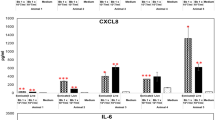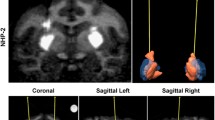Abstract
Nocardia asteroides GUH-2 (GUH-2) invades the nigrostriatal region of the brain in mice [15]. Selective dopaminergic neuronal dropout in the substantia nigra results in parkinsonian changes characterized by movement disorders responsive to L-dopa [15]. This is the only reported example of an experimental bacterial model for parkinsonism. Following i.v. inoculation of GUH-2 into the non-human primate Macaca fasicularius, the nocardiae preferentially invaded and grew within the basal ganglia (substantia nigra, caudate, putamen, and globus pallidus) often without inducing apparent inflammation. Reduced, limited growth of nocardiae occurred in the white matter of the cerebral cortex, medulla, and hippocampus, whereas neither significant adherence to nor growth within the meninges was observed. Twenty-four hours after injection, nocardial cells were found within capillary endothelial cells, the basal lamina, neurons, astroglia and in axonal extensions. The bacteria, in endothelial cells, were surrounded by a unit membrane, but in the basal lamina they appeared to be free and not membrane bound. After the organisms passed into the brain parenchyma, the nocardiae once again became surrounded by membrane, often being encapsulated by numerous layers with the innermost layer tightly adherence to the bacterial surface. There was a propensity for nocardial growth within and along myelinated axons, either with or without disruption to the surrounding myelin sheath. There was electron microscopic evidence that the nocardiae induced a neurodegenerative response especially in the substantia nigra region. Thus, the early interactions of GUH-2 within the primate brain appeared to be similar to those reported in the mouse.
Similar content being viewed by others
Author information
Authors and Affiliations
Additional information
Received: 23 September 1999
Rights and permissions
About this article
Cite this article
Beaman, B., Canfield, D., Anderson, J. et al. Site-specific invasion of the basal ganglia by Nocardia asteroides GUH-2. Med Microbiol Immunol 188, 161–168 (2000). https://doi.org/10.1007/s004309900030
Issue Date:
DOI: https://doi.org/10.1007/s004309900030




